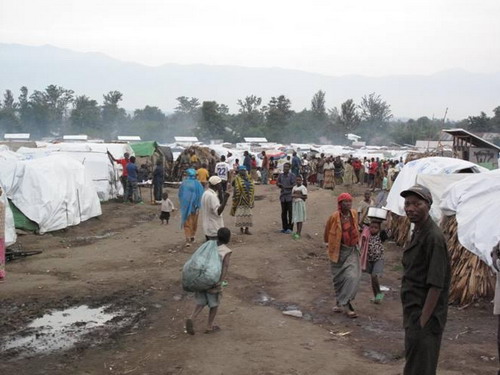 |
| Courtesy of Wiki Commons |
For the last 15 years the Congo
International actors are
growing concerned over the Congo Beligium , China , and the United States Uganda
and Rwanda ’s involvement in
the second Congo
The conflict is complicated
because of allegations that link Rwanda United States
criticized Rwanda Rwanda Rwanda
However, nearly two decades earlier, in response to the
genocide in Rwanda , Rwandan troops entered eastern Congo
 |
| Courtesy of Wiki Commons |
Of course this isnt
the first time refugees have been gathered up to be slaughtered. The attack on Burundian and
Rwandan refugees by anti-Mobutu forces which resulted in 100 dead civilians, is
a perfect example. During this time period, THE AFDL (Alliance des Forces
Democratiques pour la Liberation du Congo-Zaire), a rebel group devoted to
overthrowing Mobutu, tried to galvanize other Congolese citizens to kill Hutu refugees by comparing them to “Pigs”
and telling them that the Hutus were going to kill them. Anytime the AFDL
stumbled upon a Hutu refugee camp they responded with indiscriminate firepower
that killed numerous refugees.
The
violence against innocent civilians by all armed-combatants wasn't limited to
torture and execution many used rape excessively to dehumanize their opponents.
In 1995 the Zairian security group, Civil Guard, raped women near Kindu. Two
years later, eye-witnesses note that the AFDL raped women during an attack on
refugees trying to reach the UNHCR in order to be transported back to Rwanda
Another
common theme throughout much of the conflict was the use of child soldiers. Near
the beginning of the second war in 1998, children were recruited in the Katako-Kombe
region. These children help transport arms, and stolen property, they were
often abused and subjected to humiliating punishments. Boys were forced to rape
young girls in an effort to make them men, if they refused they were executed.
In response, the International Criminal Court has charged specific individuals
with unlawfully enlisting children into combat and issued warrants for their
arrests.
All these massacres were
recorded in a comprehensive leaked report issued by the United Nations
Commission on Human Rights. The report analyzed over 600 violent occurrences
between 1993 until 2003, the document, which catalogues the atrocities
committed in three separate time frames, showcases Congo Rwanda
threaten to pull troops out of Darfur if it
were published.
Of course the violence didn’t
begin with the AFDL. It was the former Congolese leader Mobutu Sese Seko, who
created an environment rich in hostility and brutality. Near the last few years
of his presidency, Mobutu, in conjunction with the Union of Federalist and
Independent Republicans, created a military group, JUFERI, that carried out
attacks on civilians. The attacks were mainly aimed at the Kasaians, an economically-rich
ethnic group, which attempted to coordinate attack with another ethnic group to
topple the Mobutu regime. Numerous Kasaians were killed, expelled or tortured.
 |
| Courtesy of Wiki Commons |
There are multiple reasons why
the Congolese people were eager to overthrow Mobutu. In an effort to
concentrate political power, Mobutu eliminated a multi-party system, and took
control of the legislative and judicial branches. Furthermore, the
imprisonment, harassment, and torture of opposition groups made it difficult for
democracy to evolve. In addition to the former Zairian leader’s political
malfeasance, it was his greed, coupled with incompetent economic policies that alienated
the Congolese further. It was estimated that Mobutu accumulated between five to
8 billion dollars. Of course it wasn’t just Mobutu stealing money from the
citizens, a general’s wife was stopped while she was carrying 17 briefcases
filled with money.
Mobutu’s failed economic programs such as the Maluku steel mills, Inga
hydroelectric plant, and the domestic auto-industry are just some illustrative
examples. During Mobutu’s regime, inflation rose by 1,000 percent while the
national debt ballooned and production halted. This is a bit unusual given the
fact that the Congo Zaire
It’s reasonable to assume that Mobutu’s
ascendency into political office in 1965 was a direct result of United States intervening in central Africa in an attempt to derail Soviet expansionism during
the Cold War. During that time the United States
In contrast to conflicts in the
Middle East, such as Syria Congo Congo
Approximately 80 percent of all minerals,
are taken from the mine without begin accounted by the government. Moreover,
over a billion dollars of potential government revenus from exporting gold
alone is not added to the gverment's budget every year.
The Congo can not grow economically until it can figure out a way to minimize the violence throughout the country. As of yesterday, the BBC reported that the international community, is calling on all citizens to turn in their arms or be listed as a rebel fighter. Ultimately, stability in the region, will depend on the effectiveness of the UN brigade.
The Congo can not grow economically until it can figure out a way to minimize the violence throughout the country. As of yesterday, the BBC reported that the international community, is calling on all citizens to turn in their arms or be listed as a rebel fighter. Ultimately, stability in the region, will depend on the effectiveness of the UN brigade.

No comments :
Post a Comment